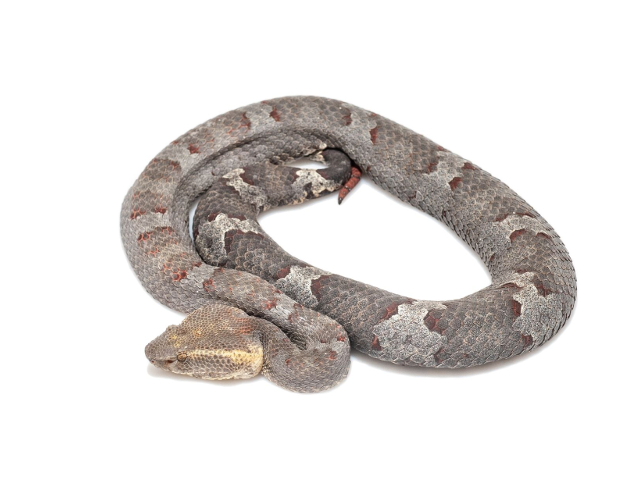Flat-Nosed Pit Viper - Trimeresurus Puniceus
 |
| Flat-Nosed Pit Viper |
Trimeresurus puniceus is a venomous pitviper species endemic to Southeast Asia. Common names include: flat-nosed pitviper, flat-nosed pit viper, and ashy pit viper. No subspecies are currently recognized.
| Kingdom | Animalia |
| Phylum | Chordata |
| Subphylum | Vertebrata |
| Class | Reptilia |
| Order | Squamata |
| Suborder | Serpentes |
| Family | Viperidae |
| Subfamily | Crotalinae |
| Genus | Trimeresurus |
| Scientific Name | Trimeresurus puniceus |
Appearance:
The general body-type of this species is in the basis similar to many of the arboreal Trimeresurus species. The head is well defined from the neck. The neck is slender and also the body is long and slender. But they do have a more heavy or broader body-type then most of the arboreal species. The head is relatively big, especially those of the females, and has a long triangular shape. The front of the head is a bit flat and pointed, but does not have the well pronounced horizontally flat, raised scute or scale as can be seen with the Trimeresurus wiroti. On the snout, from the upper till bottom lip a clear light line is visible. The overall body colour can be very variable. Most specimens seem to have a (light)brown base colour with a darker brown pattern of unregular bands and blotches. Most of the time the bands do not extend on the sides or ventrals. But colours can differ from orange, reddish till yellow and even pale grey. Expected is that there is a form of dimorphism between the population of Java and the lesser known and kept Sumatran species. But this is not described or studied well enough to make a clear statement about. The ventrals are light with an often dark chaotic pattern. Males are easy to distinguish from the females, they have a more slender body, smaller and less triangular head, more contrast and colours in the pattern (especially as young) and stay smaller. Adult males will normally measure 60-70cm while females can measure 100-130cm in length, making it one of the bigger Trimeresurus species. The tail of the males is clearly longer and has a broader base behind the cloaca.
Habitat:
Most specimens in captivity originate from Java and sometimes Thailand. But this species can also be found in the South/Eastern parts of Malaysia, on Sumatra, Borneo, Mentawai islands. There is not a lot of information about their natural range. But they seem to prefer to live in humid sub-tropical or tropical forests with a thick vegetation. Elevations can differ between almost sealevel and 1450M. This makes it harder to select the proper temperature gradients. But we can assume they prever (sub)tropical tempatures. Little difference between temperatures in seasons but experience a clear rainseason. Also we must realize temperatures are more stable but often lower on the rainforestfloor compared to the canopy and less vegitated areas along forest edges.
Behaviour:
Flat-Nosed Pit Vipe rmostly has a foul temper. None of the species in the genus can be called ‘calm’ and most are defensive. But the T. puniceus will not hesitate to strike when they feel anywhere near threatened. Bites are often prolonged and strong and they have long teeth. Luckily this species is not responsible for many bite incidents in their natural range as they prefer thick (tropical) forests, are nocturnal and do not come in contact with people often.
It is an almost strictly nocturnal species that hides between leaves and bark on the forest floor. They are not active hunters but very accurate sit and wait predators. When the sun sets they will often climb on top of a log, lay between roots or hang on a low branch with their head pointed down waiting for a prey to pass. This species is mostly terrestrial but can climb very well and will do so. In the terrarium they will hang in branches, especially after a good misting.
Venom:
The venom is mostly heamotoxic and although most bite accidents are not fatal, permanent damage on and around the bite-area is very well possible and we cannot neglect the risk of a possible allergic reaction. This species has a big head, long fangs and delivers a lot of venom. The effects start fast and strong after an uneventful bite accident. Effects include local bruising, intense pain, swelling, bleeding, nausea and headaches. In the second stage local necrosis, tissue damage and damage to blood(vessels) will occur. This can also have a negative impact on the kidneys and liver. To prevent any major permanent damage to the bite site of appendages quick treatment is needed. There is no specific antivenim for this species but some suggest Polyvalant Green pitviper antivenin has a good effect.
Diet:
The natural diet of this species will differ upon age and season. But will mostly consist of small rodents and other mammals, birds and frogs. Young T. puniceus have a high perseverance for small frogs and lizards and some specimens have been observed catching small bats.
Comments
Post a Comment